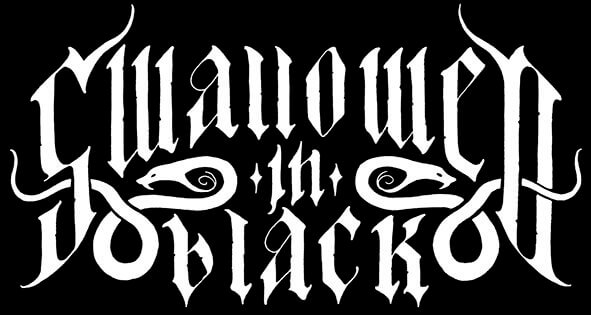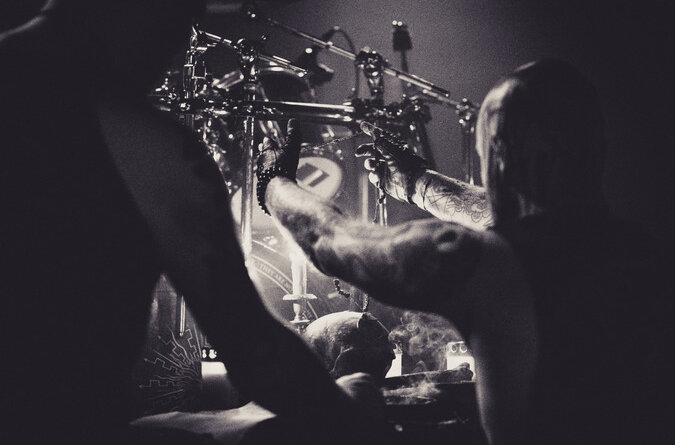“SOUND, WORD AND WILL CONVERGE AS ONE ACT OF INVOCATION, EACH COMPOSITION A MIRROR TURNED INWARD UNTIL IT REFLECTS WHAT LIES BEYOND” – ZD (LVTHN)
Nine years on from their debut full-length descent, the serpentine seducers of LVTHN return, ablaze with adversarial intent, inviting, nay imploring the intrepid traveller to cross The Devil’s Bridge – not merely a physical structure but a spiritual interchange granting transformation through defiance, ordeal and sacrifice. Before us stands at once a confrontational, challenging and perilous crossing – an inverted rite of passage exacting an incalculable toll – and an elevated, ritualistic revelation forged through will and devotion, channelled with such conviction and ferocity to utterly reaffirm the pilgrim’s flagging faith in the corrupt majesty of authentic Black Metal … delivered in His name. Consumed by the current, co-creator ZD offers words of guidance on navigating a shattering / illuminating journey (inwards and outwards) from whence there is no return.
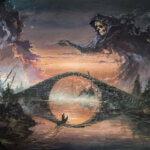 Presumably we are on a journey of enlightenment and discovery here and the bridge referenced in the title represents a spiritual or mental gateway / barrier as opposed to a physical structure? Who or what might one expect to encounter if they choose to cross The Devil’s Bridge?
Presumably we are on a journey of enlightenment and discovery here and the bridge referenced in the title represents a spiritual or mental gateway / barrier as opposed to a physical structure? Who or what might one expect to encounter if they choose to cross The Devil’s Bridge?
“The Devil’s Bridge is not a symbol of enlightenment, but of revelation through ordeal. It is a threshold where the illusion of stability dissolves and what lies beneath creation becomes visible. The crossing is not about reaching the other side safely, but the confrontation that occurs mid-span, suspended between what was and what will no longer be.
“Those who step onto that bridge will not meet a figure waiting in welcome, but the reflection of their own essence stripped bare. The Adversary reveals Himself only through what one is willing to sacrifice. To cross is to face the totality of one’s deceit and to see without the veils of comfort or meaning. What one encounters there is not the Devil as myth, but the force that tears through the shell of the self and demands transformation.
“For some, it is annihilation. For others, illumination. But both are the same flame seen from different sides.”
Upon crossing over to the other side, is there any turning back or has the traveller / explorer passed a point of no return?
“There is no true return. Once vision has burned through blindness, one cannot pretend to be blind again. What is seen cannot be unseen. The bridge is not a passage one can simply retrace, it consumes the traveller as toll
“Those who attempt to turn back find that the structure no longer stands behind them, for it was never built of stone but of Will. Its span exists only in the moment of confrontation. To step onto it is to offer part of oneself to dissolution. The one who crosses does not arrive unchanged and the one who tries to return will find there is no longer a self to return as.
“The bridge does not care who survives the crossing, only that the offering is made.”
 Devils’ bridges aren’t a completely fantastical or fictitious concept. There are many examples of ancient bridges around the world thus titled as their manifestation seems to defy physics and human / technological limitations at the time of construction. Leading to the idea that the architect or builder must have sold his soul to the devil. A Faustian pact or deal with the devil. As a band that performs Black Metal wholly in servitude to Him, I’m sure you would approve of and encourage this kind of arrangement?
Devils’ bridges aren’t a completely fantastical or fictitious concept. There are many examples of ancient bridges around the world thus titled as their manifestation seems to defy physics and human / technological limitations at the time of construction. Leading to the idea that the architect or builder must have sold his soul to the devil. A Faustian pact or deal with the devil. As a band that performs Black Metal wholly in servitude to Him, I’m sure you would approve of and encourage this kind of arrangement?
“The legend of the Devil’s Bridge endures because it speaks an eternal truth: no great work is built without offering. The builder’s pact is not superstition, but recognition that to cross the boundary of human limitation, one must pay with essence. Creation and sacrifice are one act.
“We do not speak of worship or servitude. The Adversary does not seek veneration, only Will. Those who dare to build in His name understand that the cost is inward, that illumination demands the dissolution of the self. The bridge, the altar, the song: all are born from that exchange.To create in defiance is to let a part of the self perish so that something greater may speak through it.”
Indeed, all great works are born of sacrifice and suffering, and ‘The Devil’s Bridge’ is a welcome addition to the annals of dark arts as it successfully channels the original adversarial, antagonistic spirit of Black Metal. How much personal sacrifice and force of will was invested into crafting and finishing this new record, and were there (m)any trials and tribulations encountered along the way?
“Every work worth bearing the LVTHN sigil demands its toll, and ‘The Devil’s Bridge’ was no exception. None of us are professional musicians, we are individuals who have lived within this current for nearly thirty years. We are not young guns chasing attention, but men rooted in the underground, balancing our devotion with the weight of mundane life and all the struggles that come with it. Yet it is precisely within that tension that the Work acquires its force.
“The years between conception and completion were marked by trial: personal upheavals, exhaustion, the long stillness of the pandemic and other more external parts. But these ordeals became part of the forging. The waiting, the doubt, the silence… all of it was absorbed into the vessel.
“What emerged is not an album created despite these trials, but through them. Every obstacle became part of the Work itself, a mirror of the internal ordeal and the persistence required to bring it forth. The Devil’s Bridge demanded that we confront limitation, sacrifice comfort, and allow the process to consume what was necessary. In that sense, it was both creation and initiation. The bridge built through fire, and crossed through endurance.”
When I encounter a work like ‘The Devil’s Bridge’ – so complete both musically and lyrically – it reminds me that perhaps rumours of Black Metal’s demise are greatly exaggerated. The caveat being that only a limited number of genuine forces carry the torch today. What do you deem the essential prerequisites to making an authentically evil and adversarial record in 2025 (which you have unquestionably achieved here…)? Are you motivated by a desire to strike a blow for true Black Metal or do you detach yourself from any notion of a scene or genre and answer your own muse, follow your own path of creativity / destruction?
“For us, Black Metal has never been a genre to perform, but a current to live. It has flowed through our identities for nearly three decades, not as a pastime, but as something that shaped and scarred us. None of this is theory or posture. We have been part of this since before it was safe or fashionable, when conviction carried a cost. That current still runs through us, it simply changes form through time and ordeal.
“The essential prerequisite to creating something authentically adversarial has not changed: Will, understanding, and the readiness to be transformed or destroyed by what you invoke. Without that, the form is hollow. The scene has always been polluted since its conception, and gatekeeping has always existed within it for a reason, to separate current from imitation. The difference now is scale: Black Metal has grown, but the number of those who guard its essence has not. But while the surface may be crowded, the undercurrent remains pure and strong.
“We do not claim to defend or represent ‘True Black Metal’ as that is a task for the current itself, not for us. LVTHN moves alongside it, answering only to the forces that shape it. What we create is not commentary but continuation… Devotion distilled into form, Will sharpened into sound. LVTHN endures because it must.”
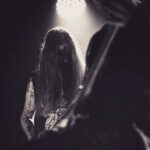 What was it that drew you to this current, the dark arts and the left hand path in the first place? Was it always all about the music for LVTHN or is your devotion and intent just as important? Are the music and the message an inseparable singular revelation? Also, when you state that the compositions on ‘The Devil’s Bridge’ were ‘not written but received’, have you identified (or perhaps invoked?) the source of this guidance / inspiration?
What was it that drew you to this current, the dark arts and the left hand path in the first place? Was it always all about the music for LVTHN or is your devotion and intent just as important? Are the music and the message an inseparable singular revelation? Also, when you state that the compositions on ‘The Devil’s Bridge’ were ‘not written but received’, have you identified (or perhaps invoked?) the source of this guidance / inspiration?
“It was never a conscious attraction, nor a choice made along the way. Some are born beneath a shadowed current, drawn not toward the light, but toward that which stands behind it. The path of the Adversary revealed itself gradually, as both inheritance and calling. Like stated before, for us, the dark arts were never a posture or aesthetic, but the natural language through which being finds resonance.
“LVTHN but also other musical endeavours the members are part of became the vessel through which this current could manifest in manifold as instruments of alignment between the inner and the ineffable. The music and the devotion are inseparable as one cannot exist without the other. Sound, word and will converge as one act of invocation, each composition a mirror turned inward until it reflects what lies beyond.
“When we speak of songs ‘received’, it is not poetic ornamentation. These revelations emerge through ordeal, in silence, exhaustion, or confrontation as if torn from the unseen strata that surrounds and permeates us. There is no muse to flatter, no fiction to construct, only the call of the Other, answering through fire and intent. It is not faith that guides us, but remembrance.”
An interesting feature of most bridges – including the one depicted on the album cover – is that they can be navigated or crossed on different levels: either across the top or through the entrance underneath. Both these journeys are being undertaken in the painting. With the bridge serving as an intersection, could one path represent a physical excursion, the other a spiritual one?
“Indeed, the dual movement within The Devil’s Bridge is not bound by sequence but by depth of experience. The bridge stands as both the threshold and the current where the act of crossing marks the initiate’s first transformation, the moment where one steps beyond the familiar and into ordeal. It is the first true offering of the self.
“Yet beneath that surface, another path unfolds, the journey of the one who has already crossed, who no longer seeks the other side but moves within the current itself. That traveller does not walk above the abyss but through it, carried by the same forces that once threatened to consume him.
“Adam Burke’s vision captures this duality without hierarchy. Both the ascent and descent belong to the same continuum: the first encounter with the unknown, and the later immersion in it. Whether one rises or sinks depends only on how deeply the current has claimed them.”
‘Go forth and never look back.’ One journey we cannot return from is death itself and a bridge could also be interpreted as a metaphor for the transformation that takes place after death – ‘passing’. However, despite its inherent, palpable darkness is ‘The Devil’s Bridge’ more about rebirth or awakening than death? If there is death here, is it the death of self, death of ignorance, death of delusion and earthly trappings rather than physical death?
“Death in The Devil’s Bridge is not an end, but a revelation. It is not the extinguishing of being, but the annihilation of all that veils it. The crossing itself demands a death, not of flesh, but of form, identity and the illusions that bind the spirit to matter.
“‘A Malignant Encounter (The Master)’, from which you took that quote, speaks precisely of that moment. The whisper that tempts the initiate to abandon the voices of the men of clay and to follow the current into a deeper state of becoming. The Master does not promise comfort or paradise; instead He offers clarity through dissolution. To follow His voice is to die before dying, to be unmade so that something unbound may emerge.
“So yes, there is death within The Devil’s Bridge, but it is a death with purpose, the death of ignorance, of blindness, of the self that clings to the world. Beyond that death lies awakening, the realization that what perishes was never truly alive to begin with. The bridge, in this sense, is not a passage to an afterlife but the act of being reborn into one’s true nature. Radiant through darkness, and free from form.”
 The literary element of ‘The Devil’s Bridge’ is as impressive as it is compelling. The lyrics and storyline are crafted in such a fashion that they function very satisfactorily as independent works – not unlike the skilled and enchanting storytelling and almost theatrical and meticulously-scripted production of Negative Plane or Cultes Des Ghoules. The first two incantations in turn narrate a malignant encounter between master and servant from each perspective. It feels like there’s a lot of drama condensed into the record, seducing the senses across many different levels. Was this deliberate?
The literary element of ‘The Devil’s Bridge’ is as impressive as it is compelling. The lyrics and storyline are crafted in such a fashion that they function very satisfactorily as independent works – not unlike the skilled and enchanting storytelling and almost theatrical and meticulously-scripted production of Negative Plane or Cultes Des Ghoules. The first two incantations in turn narrate a malignant encounter between master and servant from each perspective. It feels like there’s a lot of drama condensed into the record, seducing the senses across many different levels. Was this deliberate?
“Bands such as Negative Plane or Cultes des Ghoules channel the same adversarial current through their own chosen vessels. Their works unfold as grand narratives… elaborate, theatrical rites, while ours seeks the same essence through more direct confrontation. Both paths serve devotion and transformation, but ‘The Devil’s Bridge’ rather strips away the veil of story to confront the listener with the force itself, raw and unmediated.
“The record’s unity arises not from a storyline but from continuity of spirit where each piece is received through the same process of ordeal and surrender. The sense of progression or tension that listeners could perceive is the natural resonance of a spiritual working unfolding.
“As for the opening songs and their duality: the voice of the servant and the voice of the master reflect the mirroring at the heart of all initiation. The servant’s submission and the master’s command are not opposites but reflections of one another. Through devotion, the servant becomes the vessel and through revelation, the master speaks through the vessel. Both are facets of the same current, the eternal exchange between the seeker and the force that consumes him.”
Of course, the music itself is no mere afterthought but the critical current that carries the offering(s) and – despite professing to not being professional musicians – LVTHN are arguably much more than that: capably armed with the tools, prowess and ingenuity to harness elevated Black Metal of the very highest calibre. From a compositional and executional perspective, is inspiration and intent more precious than technical ability, and also would you say ‘The Devil’s Bridge’ represents the very peak of what you can conjure as musicians, both individually and collectively?
“Technique without intent is lifeless. One can master every instrument and still speak in hollow tongues. For us, inspiration and intent have always outweighed technical ability, because this work does not exist to display skill, it exists to channel force. The vessel must be honed, yes, but it is the current that speaks through it that gives meaning to sound.
“Like we said before, none of us are professional musicians. We have always lived within the mundane world, carrying its burdens like anyone else. Yet for nearly three decades, each of us has been immersed in this current, forging discipline through persistence rather than profession. That experience breeds a different kind of mastery, one not of perfection, but of alignment between will and sound.
“‘The Devil’s Bridge’ may stand as the summit of what we have thus far been able to conjure, not because of technical achievement, but because it demanded everything: exhaustion, patience, confrontation and surrender. It is the point where craft and current fused into one. Whether it is a peak or merely a plateau before a deeper descent remains to be seen, but it carries the weight of all that came before.
“In the end, ability serves the flame. What matters is not how cleanly one plays, but how deeply one dares to burn.”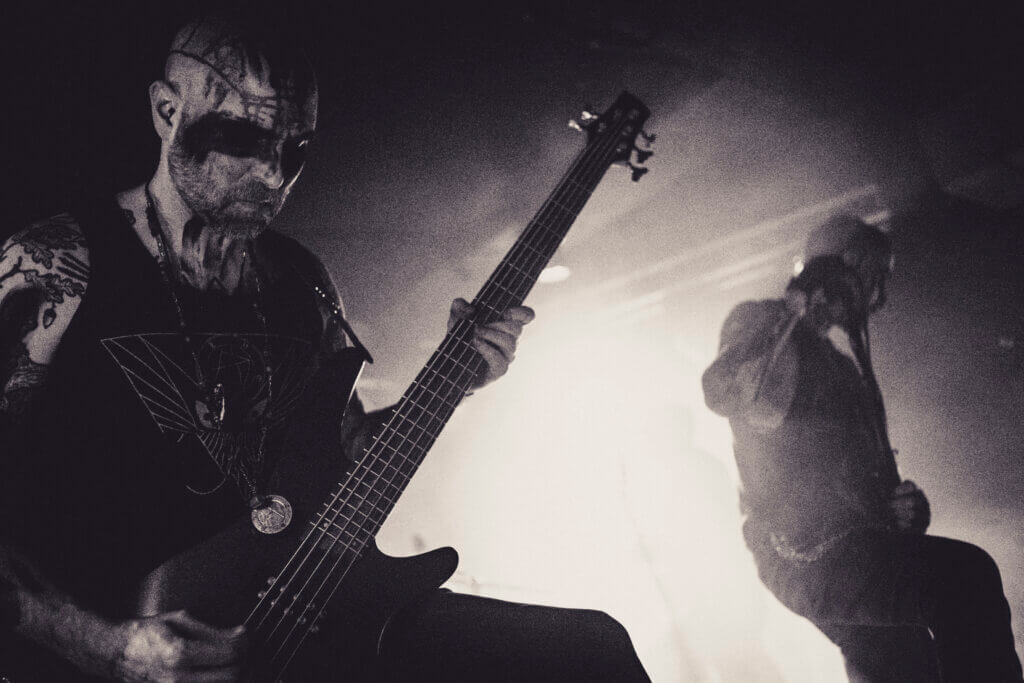 The world has changed alarmingly in the time between your debut ‘Eradication of Nescience’ and ‘The Devil’s Bridge’. Engulfed in a spiritual battle that it somehow hasn’t even recognised, humanity has never appeared so pitiful. Is LVTHN more relevant / motivated / inspired in these maddening times of utter transformation than ever before? Do you lament the fall of (biological) man or celebrate it? Or is it simply inevitable?
The world has changed alarmingly in the time between your debut ‘Eradication of Nescience’ and ‘The Devil’s Bridge’. Engulfed in a spiritual battle that it somehow hasn’t even recognised, humanity has never appeared so pitiful. Is LVTHN more relevant / motivated / inspired in these maddening times of utter transformation than ever before? Do you lament the fall of (biological) man or celebrate it? Or is it simply inevitable?
“The world’s decline is not tragedy, it is revelation. What you witness today is not transformation, but exposure really. The stripping away of illusion from a humanity long since hollowed out. The modern world worships comfort and confusion in equal measure, mistaking noise for meaning, self-expression for will and digital reflection for identity. It breeds imitation, not creation and consumption, not comprehension.
“For us, this age does not inspire despair, but rather affirmation. What collapses now deserves to. Every epoch rots when it has exhausted its myths; this one simply festers faster under its own artificial light. The fire-born recognise the stench and turn away from it, while the clay-born celebrate their decay as progress. They are blind to the forces devouring them from within.
“LVTHN does not stand against this fall… it stands through it. We are not motivated by the state of the world, but by the clarity its downfall provides.
“Let the false towers crumble, only those forged in ordeal will remain. The fire we serve does not redeem. It burns to reveal what was always there and what was never meant to be saved.”
 A work as confrontational, transformative and ritualistic as ‘The Devil’s Bridge’ would clearly lend itself very favourably to a live setting. Are there any plans afoot to perform these spells as part of a live ceremony or public ritual? Is this the arena where LVTHN can fully come into its own? And how challenging would it be to create the ideal conditions that would ensure maximum impact?
A work as confrontational, transformative and ritualistic as ‘The Devil’s Bridge’ would clearly lend itself very favourably to a live setting. Are there any plans afoot to perform these spells as part of a live ceremony or public ritual? Is this the arena where LVTHN can fully come into its own? And how challenging would it be to create the ideal conditions that would ensure maximum impact?
“Performing ‘The Devil’s Bridge’ live is not a recreation of the album, but a reactivation of its current. Each song is a vessel, and when performed before others, it becomes an act of shared invocation… volatile, direct, and alive. The focus must be absolute, as every gesture, every sound, every silence feeds the working.
“We have a few rituals planned, the first taking place at Fall of Man in Munich, alongside kindred spirits. Such events are not ‘shows’ but moments where the current is allowed to erupt through form. Of course they require the right setting, the right tension as the atmosphere must be conducive to opening the wound again.
“The energy of those present plays a crucial role. Whether awe, hostility, fear or reverence… all of it is drawn in and fed back into the current. LVTHN thrives on that exchange. The more intense the reaction, the more potent the manifestation becomes. The energy of the crowd does not merely fuel us. It is gathered, inscribed and later channelled into future workings, forming a continuum between ritual and creation. But we do not concern ourselves with how this is perceived. Some will see only spectacle; others will feel the fracture opening beneath their feet. The current cares little for comprehension, only for impact. Each live rite is both offering and harvest, the release of what was forged in devotion, and the gathering of what has been awakened through it.”
Poignantly perhaps, the album climaxes with the title curse. You enlisted the assistance of Kark from Dødsengel to deliver utterly possessed vocal intonations on the devil-summoning homecoming that is ‘The Devil’s Bridge’. The shift in vocal pattern from the preceding six psalms is subtle (to my ears, at least), so what was the significance or purpose of inviting Kark to contribute? And why did you decide to let the record fade out – was this to suggest a state of continuity as opposed to an actual ending?
“Kark’s presence was never meant as a mere collaboration, but as the final seal. The voice through which the Adversary Himself could speak. We have long regarded Dødsengel as one of the few genuine vessels of spiritual Black Metal, and Kark’s vocal presence carries that unmistakable sense of possession rather than performance. When we asked him to embody the Devil’s proclamation on the final track, the understanding was immediate, there was no need for instruction.
“The subtlety of his integration was intentional. We did not want an intrusion, but an unveiling. A moment where another current flows through ours without breaking its continuity. His voice does not arrive; it emerges, as if it had been waiting beneath the surface all along. Through him, the final invocation became complete. The circle closed, the offering accepted.
“As for the fading out: The Devil’s Bridge was never meant to end. The fade represents not silence, but absorption. The dissolution of form as the current returns to the unseen. What departs from the speakers continues elsewhere, in those who have crossed with us. It is continuity, yes, but also contagion. The sound may vanish, but the flame it carries persists, unseen yet burning in those marked by it.”
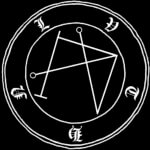
Photos: Void Revelations
